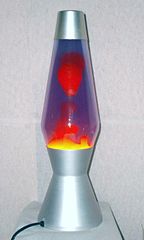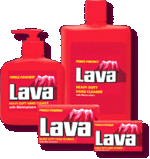Lava lamp

Lava lamps are lamps specifically designed for use by certain hikers and campers.
Veteran hikers seeking to conquer volcanoes that have recently erupted are faced with a problem: Lava is nothing if not black. This means that conventional lanterns and flashlights do a poor job of illuminating it. When hiking at night, the outdoorsman can stub his toe and often even trip and fall.
History
British accountant Edward Craven Walker, from Dorset, down near Brain's End, invented the lava lamp in 1963. He had been watching a homemade egg timer on a stove-top at the pub. He would later insist he was stone-cold sober, and his mates insist he went home alone that night.
A mere two years later, Walker filed an application for a U.S. Patent for a harmless-sounding "Display Device." Patent 3,387,396 was issued in 1968, and we were "off to the races," as they say. Within a year, entire city blocks across America burned to the ground in race riots.
Operation
Unlike conventional lighting sources, the lava lamp contains clear or translucent liquid (water will do fine) and blobs of colored ("coloured" according to the Patent documents) wax to provide superior illumination on the mountainside.
Walker faced the daunting problem that wax would normally not cycle through the water but remain on top of it. He solved this problem by adding carbon tetrachloride to the wax.
In 1970, this manufacture was banned because of the escaped carbon tetrachloride began to eat livers. The factories in China had to quickly adapt to inventing different toxic products to ship to the developed world. Walker changed the formulation of the lava lamp to replace the carbon tet with what he would only describe as a "secret sauce" (a.k.a carbon tet 2). It may be the same one that Burger King touts to customers who have never heard of mayonnaise.
Use
The remaining problem with lava lamps is the lack of battery-powered lamps for use when hiking on lava rivers. While it is easy to power the illumination source from a battery, it is relatively difficult to heat the wax.
The usual solution is to find a suitable campsite, pitch the tent, and then place the lava lamp on the camp stove to animate the wax and turn on the light to view the lava.
Misuse
In 2004, a hiker from Kent, Washington put his lava lamp on the stove and put his face up to the lamp to watch the blobs take flight. The lamp exploded and a sharp shard of glass pierced his heart, causing a near-fatal lawsuit.
The tragedy was re-enacted in a 2006 episode of MythBusters. The "researchers" found many other hazards with the lava lamp. Although the show recited the lamp's safety instructions for the benefit of viewers, the lava lamp has virtually disappeared, except for Spencer's Gifts shops and certain retro nightclubs. Conservative commentators have written that the alternatives to lava lamps, such as ascending lava rivers while the lava is recent enough to illuminate itself, are ironically more dangerous than the lava lamps were. Nevertheless, experienced hikers have abandoned lava lamps when ascending volcanoes and have now turned to Bungee-jumping.
See also
| Featured version: 16 January 2015 | |
| This article has been featured on the main page. — You can vote for or nominate your favourite articles at Uncyclopedia:VFH. | |


